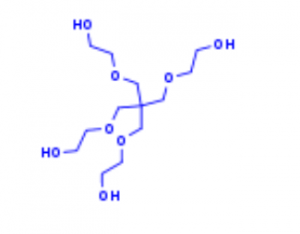Allyl chloride is toxic. Allyl chloride (162.8 mL, 2 mol) was added to a solution of tetrahydroxymethylmethane (13.6 g, 0.4 mol OH groups), tetrabutylammonium bromide (TBAB) as phase‐transfer catalyst, and NaOH (80 g, 2 mol) in distilled water (80 mL), and the reaction mixture was then stirred for 24 h at 50 °C. After the addition of toluene (400 mL), the organic phase was separated, dried over MgSO4, filtered,and concentrated under vacuum. The crude product was further purified by column chromatography (silica gel, petroleum ether/ethyl acetate 10:1 to 1:1) to give a colorless oil. In some cases the product had a tendency to slowly polymerize (especially at higher generations). For long‐term storage, it was necessary to keep the allyl ether product under an inert atmosphere at −20 °C.
Ozone was bubbled through a solution of compound 3 (2.82 g, 6.88 mmol) in dichloromethane−methanol (150 mL, 1:1) at −78 °C until the reaction mixture turned blue, and the complete consumption of the olefin was then verified by TLC. After the removal of residual ozone by bubbling nitrogen through the solution for 25 min, excess dimethyl sulfide was added at −78 °C and the resulting solution was then allowed to warm to room temperature and then concentrated. The oily residue was dissolved in ethanol (100 mL) and cooled to 0 °C (ice−water bath). Sodium borohydride (3.90 g, 100 mmol) was added in portions. After the reaction mixture was allowed to reach room temperature, it was stirred for a further 24 h. Water (50 mL) was added and the reaction mixture was acidified with 20% HCl to pH 6 (pH paper), then filtered. The filtrate was concentrated and the residue was extracted with dichloromethane (3 × 30 mL). The combined extracts were dried (MgSO4) and concentrated. Purification of the residue by flash column chromatography (pure EtOAc, Rf 0.28) afforded the title compound as a viscous colorless oil (2.35 g, 81%).




